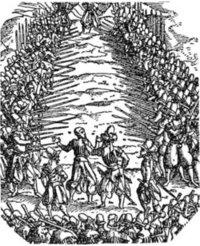Tae Kwon Do Birthday Gauntlet
When it is ones birthday, he must face the gauntlet if he comes to Tae Kwon Do class. The students and instructor form two parallel lines, showering the individual with kicks and punches as runs through the lines. Often the individual would try to hide the fact that it is his birthday; however, if the instructor or another student finds out, he sounds the shouts it out to the studio and the two kicking lines are formed. This usually happens after class is already over.
I experienced this tradition when I used to attend the J. Lee Tae Kwon Do Center in Hermosa Beach, California. I started when I was six years old and continued until my senior year in high school, earning my third degree black belt in the process. My instructor was Grand Master Jae Heon Lee, an accomplished martial artist who had previously served as coach of the Japanese national team and appeared on the covers of numerous Tae Kwon Do magazines.
When I first saw this tradition in action I was surprised. I as probably around six or seven, in a beginner level class, with other children about the same age as I. We were all confused when were told to form lines and kick the birthday boy as he ran between us. However, in the subsequent years we quickly caught on. As rivalries formed and anger and bitterness between students developed, these birthday gauntlets took on a different meaning. While it was imperative that control be used, a cheap shot at the running student could easily be slipped in. The easiest way was to inflict damage was to kick the student as he ran toward you; while most kicked him on his backside as he passed, one solid roundhouse kick to his front torso, depending on where it hit, could either knock the wind from him or leave him crumpled on the ground.
Still, this sort of incident was rare, as everybody was wary of retaliation. In Tae Kwon Do there is a multitude of ways to take out ones anger on another without facing disciplinary consequences. During sparring or kicking practice individuals often had accidents where they slipped and ended up striking another person they disliked in a painful area. At very least the person knew they would have a free shot at the other person on his birthday. Thus it was not productive to anger a rival at the studio, as there were so many ways in which he could easily retaliate. Our studio was all in all a harmonious place; everybody got along pretty well and I formed many lasting friendships there. Still, as it was a competitive place, it would be foolish to say that there were not rivalries and even at times open feuds.
 The use of a mock physical punishment during ones birthday is similar to the Western tradition of giving one a number of spankings, pinches, or punches on his birthday.
The use of a mock physical punishment during ones birthday is similar to the Western tradition of giving one a number of spankings, pinches, or punches on his birthday.
This concept of running through two lines where one is attacked on both sides is well known. Usually called running the gauntlet, it is well established in history. In the archaic picture to the right, a couple of European captives are being forced to run the gauntlet by their captors. I have taken six years of Latin and have continued my study of the language here at USC. In ancient Rome, the gauntlet was used as a brutal form of execution. Execution in this manner was given the term fustuarium. The Jesuit Isaac Jogues recorded this gauntlet as a practice of the Native American Iroquois Indians. Having experienced it himself as a prisoner in 1641, he describes it in a letter that appears on page 163 of the book The Jesuit Martyrs of North America, published in 1925 by The Universal Knowledge Foundation.
